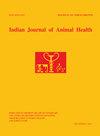山茶提取物对自闭症大鼠幼鼠神经化学和氧化变化的治疗作用
IF 0.5
4区 农林科学
Q4 AGRICULTURE, DAIRY & ANIMAL SCIENCE
引用次数: 0
摘要
背景:产前暴露于丙戊酸盐能够诱导实验性大鼠幼鼠自闭症。本研究旨在探讨茶树绿茶提取物(GTE)对自闭症大鼠神经化学变化的改善作用。方法:妊娠大鼠于妊娠第12.5天单次腹腔注射丙戊酸钠(600 mg/kg)。GTE (300 mg/kg)于出生后第15天口服给药,持续20 d。结果:自闭症诱导大鼠小脑及皮质5-HT、DA、NE、GABA、甘氨酸、牛磺酸含量显著降低,脑内胆固醇、抗氧化酶(GSH、SOD、CAT)含量显著降低(P < 0.05)。此外,GTE通过激活GSH、SOD和CAT水平,改善了小脑和大脑皮层的抗氧化防御系统。这些结果伴随着氧化应激生物标志物(NO和MDA)的显著降低以及TNF-α和IL-6水平的降低。综上所述,GTE可能通过抗氧化和抗炎作用对自闭症大鼠幼鼠产生改善作用,可能是治疗自闭症的有效手段。本文章由计算机程序翻译,如有差异,请以英文原文为准。
Therapeutic Potency of Camellia sinensis Extract on Neurochemical and Oxidative Changes Correlates to Autistic Disorder in Rat Pups Model
Background: Prenatal exposure to valproate is capable of inducing experimental autism in rat pups. This study aimed to investigate the role of Camellia sinensis green tea extract (GTE) in ameliorating the neurochemical changes induced by autism. Methods: Pregnant rats were treated with a single intraperitoneal dose of sodium valproate (600 mg/kg) on the 12.5th gestational day. The treatment with GTE (300 mg/kg) orally in autistic rat pups at postnatal day 15 for 20 days. Result: Induction of autism resulted in a significant decrease in the cerebellum and cortical 5-HT, DA, NE, GABA, glycine and taurine and a decrease in brain cholesterol and antioxidants enzymes (GSH, SOD and CAT) at P less than 0.05. However, it showed a significant increase in MAO, AChE, glutamate, aspartate, serine and lipid peroxidation in addition to elevation in inflammatory biomarkers in brain tissue. Treatment with GTE extract showed significant decrease in AChE and MAO in addition to reduction in the excitatory amino acid GABA in brain tissue which in accordance resulted in marked elevation in cerebellar and cortical monoamine contents. Furthermore, administration of GTE improved the antioxidant defence system in cerebellum and cerebral cortex by activating the level of GSH, SOD and CAT. These results are accompanied by marked reduction in oxidative stress biomarker (NO and MDA) and lowering in the level of TNF-α and IL-6. In conclusion, it could be stated that GTE exerts an ameliorative effect on autistic rat pups possibly due to antioxidant and anti-inflammatory effects and could be effective in the management of autism.
求助全文
通过发布文献求助,成功后即可免费获取论文全文。
去求助
来源期刊

Indian Journal of Animal Research
AGRICULTURE, DAIRY & ANIMAL SCIENCE-
CiteScore
1.00
自引率
20.00%
发文量
332
审稿时长
6 months
期刊介绍:
The IJAR, the flagship print journal of ARCC, it is a monthly journal published without any break since 1966. The overall aim of the journal is to promote the professional development of its readers, researchers and scientists around the world. Indian Journal of Animal Research is peer-reviewed journal and has gained recognition for its high standard in the academic world. It anatomy, nutrition, production, management, veterinary, fisheries, zoology etc. The objective of the journal is to provide a forum to the scientific community to publish their research findings and also to open new vistas for further research. The journal is being covered under international indexing and abstracting services.
 求助内容:
求助内容: 应助结果提醒方式:
应助结果提醒方式:


